INDIAN ARMED FORCES CHIEFS ON OUR RELENTLESS AND FOCUSED PUBLISHING EFFORTS

The insightful articles, inspiring narrations and analytical perspectives presented by the Editorial Team, establish an alluring connect with the reader. My compliments and best wishes to SP Guide Publications.

"Over the past 60 years, the growth of SP Guide Publications has mirrored the rising stature of Indian Navy. Its well-researched and informative magazines on Defence and Aerospace sector have served to shape an educated opinion of our military personnel, policy makers and the public alike. I wish SP's Publication team continued success, fair winds and following seas in all future endeavour!"

Since, its inception in 1964, SP Guide Publications has consistently demonstrated commitment to high-quality journalism in the aerospace and defence sectors, earning a well-deserved reputation as Asia's largest media house in this domain. I wish SP Guide Publications continued success in its pursuit of excellence.
- Prime Minister Modi Visits Punjab’s Adampur Air Base, Interacts with Airmen after Successful ‘Operation Sindoor’; Stern Message to Pakistan
- The layered Air Defence systems that worked superbly, the key element of Operation Sindoor
- Operation Sindoor | Day 2 DGMOs Briefing
- Operation Sindoor: Resolute yet Restrained
- India's Operation Sindoor Sends a Clear Message to Terror and the World – ‘ZERO TOLERANCE’
- Japan and India set forth a defence cooperation consultancy framework, talks on tank and jet engines
Clear Skies Ahead
IAF's pursuit of Air & Space Supremacy amid a surfeit of challenges
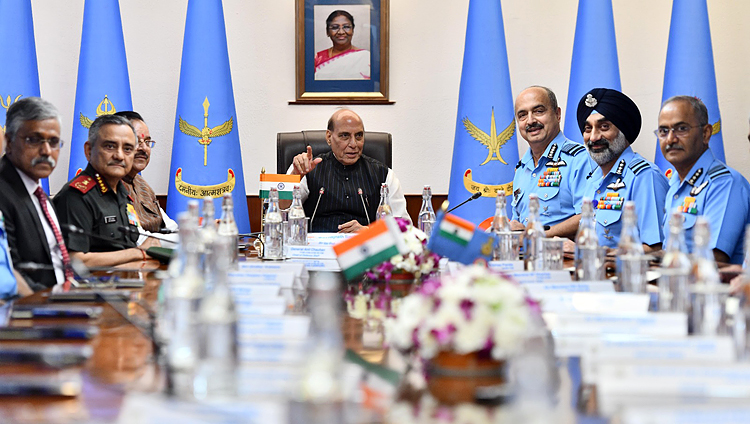
The IAF has, over the years, transformed into a modern aerospace power that is capable of controlling and exploiting air and space environments to achieve India's national and security objectives. Over the years, IAF's projection of capability concepts has progressed on operational experiences of real conflict situations as well as exercises within the country and with friendly foreign air forces. Many lessons learnt from these experiences have found a place in the doctrinal space while some of the elements continue to be assimilated incomprehensive discourse based on the fast-progressing air and space areas--for the future.
IAF's projection of capability concepts has progressed on operational experiences of real conflict situations as well as exercises within the country and with friendly foreign air forces
The IAF's firepower and air superiority stem from aerospace power's capabilities in terms of reach, mobility, responsiveness, offensive lethality, and trans-domain operational flexibility in air to near space. The multi-role capabilities of platforms and weapon systems offer wide-ranging opportunities, capable of rapid role change which provide multiple options to the aerospace power practitioner.
IAF capability roadmap: How does it look at the moment?
IAF currently has 31 fighter squadrons and will be inducting 83 LCA Mk1A from 2024 onwards. LCA Mk1A is already flying. Development of LCA Mk2 and AMCA—albeit slowly—is moving towards a fifth generation capability with the locally manufactured jet engine –based on technology gains from GE F414 aero-engine and domestic R&D efforts. At the same time, the IAF is also pursuing the older MMRCA initiative which is now christened 114 MRFA (Multi Role Fighter Aircraft) to bridge the gap of depleting squadron strength. In fact, recently, the Chief of the Air Staff (CAS) has spoken about it firmly, giving some wings for MRFA to take off from the hanger, if not the ground.


(Top Left - Right) LCA MK-2; AMCA (Above Left - Right) LCH Prachand; IMRH
However, the silver lining is the helicopter fleet which is indeed a greater success story from the house of IAF. One by one, the multi-role fleet of helicopters –all built/integrated indigenously at HAL—is being induced which includes the Light Combat Helicopter (LCH Prachand), Advanced Light Helicopter – Weapon Systems Integrated (ALH WSI), and planned induction of Indian Multi-Role Helicopter (IMRH). Already, a total of 6 LCHs Limited Series Production (LSP) aircraft have been handed over to the IAF. The twin-engine LCH has shown operational capability at 6.5km altitude with an adequate payload with electro-optical CCD/ FLIR Pod, taking the unique position to land and take off at an altitude of 5,000 metres.
The LCH is loaded with Gen-III NVGs, anti-tank guided missile Dhruvastra and air-to-air missile Mistral-2 from MBDA, making India the seventh country in the world to do so.
IAF currently has 31 fighter squadrons and will be inducting 83 LCA Mk1A from 2024 onwards
Among the clusters, the IMRH is another promising air asset in the 10-15 Tonne class based on a new powerful 3000 Shaft Horse Power (SHP) engine developed jointly by Safran and Hindustan Aeronautics Ltd (HAL) called-- Safhal Helicopter Engines Pvt Ltd. This is indeed a progressive area with a proven collaboration for the Shakti engine (the Ardiden1H1), incorporating innovative propulsion technology, which powers the Dhruv, the Armed Dhruv as well as the LCH. Each of these helicopters is powered by two engines, each producing a SHP 1400-2000 per engine – more than 500 Shakti engines have been produced by HAL. How capable it would be: For example, American made AH-64E Apache, is fitted with two General Electric T700-GE-701D turboshaft engines with an SHP of 2000 each, which enables it to carry a lethal package of armaments over high altitudes in Ladakh at ease.
The IMRH will replace older Russian Mi-17I Medium utility helicopters. So far, IMRH has crossed the Preliminary Configuration for the basic IMRH platform based on Operational Requirements (ORs) given by IAF.
IAF's Concept of Operations (CONOPS)
The emergence of asymmetric and hybrid warfare concepts requires IAF to dovetail their Space and Information Warfare capabilities into the CONOPS to ensure an operational continuum. For the IAF's power projection, Network-centric warfare is the most fundamental with Offensive and Air Defence Operations based on an Integrated Air Command and Control System. At the same time, enterprise-level digitisation drives the techno-logistics and administration aspects of the IAF. While networking and automation have enhanced operational efficiency at all levels, the precept of conduct of air operations through 'Joint Planning, Centralised Command, Distributed Control and Decentralised Execution' remain at the core of our doctrinal belief. In this context, the doctrine has been reviewed after studies on op applicability, combat leadership and conduct of air war in all possible scenarios.
The Intelligent Eyes IAF
Currently, India is planning to develop and introduce 12 more "eyes in the sky" advanced indigenous airborne early-warning and control (AEW&C) aircraft to counter the air surveillance advancements of China and Pakistan. The IAF and the Defence Research and Development Organisation (DRDO) are jointly developing six Mark-1A and six Mark-2 versions of the Netra AEW&C aircraft.
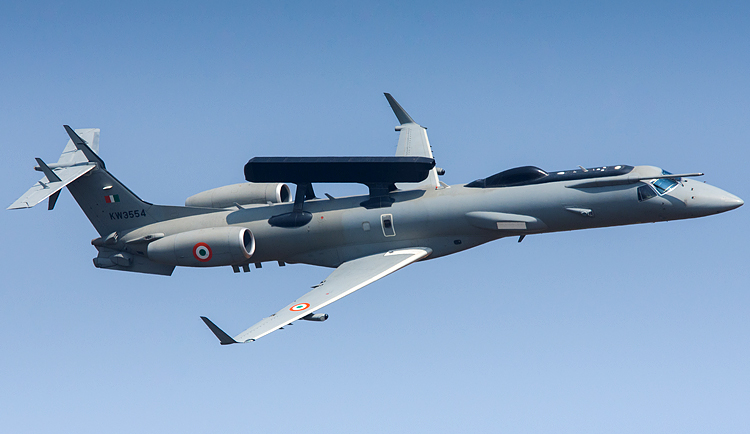
The Indian Air Force (IAF) has also kickstarted the indigenous Netra-I Airborne Early Warning and Control aircraft programme. This programme is based on the Brazilian Embraer aircraft where six AEW&C aircraft will be like the first three Embraer-145 jet-based Netra, which have 240-degree radar coverage with advanced software and technologies like new gallium nitride-based TR (transmit/receive) modules for the radars loaded with signal intelligence systems at an estimated cost of around 9,000 crore. Besides, boosting EW&C radars and sensors on second-hand Airbus-321 planes acquired from Air India which is currently underway at a cost of 10,990 crore.
It was evident during the cross-border Balakot air strikes and ensuing aerial engagement with Pakistani aircraft which were supported by Saab 2000 Erieye AEW&C. A simple comparison shows the importance of AEW&C jets; Pakistan operates 11 Swedish Saab 2000 Erieye AEW&C and China-made Karakoram Eagle ZDK-03 AWACS aircraft, while China possesses about 30 AEW&C aircraft, such as Kong Jing-2000 'Mainring', KJ-200 'Moth', and KJ-500 models with next- general and much advanced AWACS in the process of being inducted.
Technology in Aerospace Application
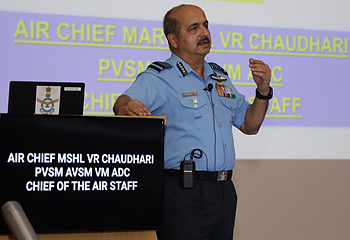
The air and near space domains are increasingly a continuum for the IAF due to the increasingly high dependency on ISR, navigation, imagery, targeting, meteorology, communication, operational networks, command and control, enhanced AD responsibility etc.
Air Chief Marshal V.R. Chaudhari, Chief of the Air Staff has recently highlighted space-based applications like Positioning, Navigation & Timing (PNT), ISR and Communication. IAF is leveraging the advancement in space with ISRO. Currently, IAF is using GSAT 7A, a satellite expanding on UHF, S, and Ku bands with a coverage area of the Indian Ocean Region (IOR) up to 2,000 km from the Indian coastline to secure communication real-time between naval assets, including ships, submarines, and aircraft. It adds to the interoperability with other military forces—a key component for joint military exercise in emerging conflicts in the region.
Air Chief Marshal V.R. Chaudhari, Chief of the Air Staff has recently highlighted space-based applications like Positioning, Navigation & Timing (PNT), ISR and Communication
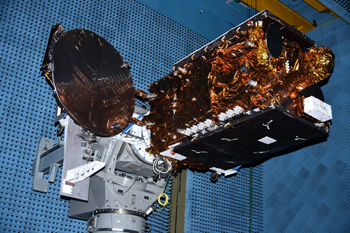
These clusters of satellites --GSAT-7 (Rukmini), GSAT-6, and GSAT-7A (Angry Bird) support the communication needs of more than 50 naval ships and aircraft across the Arabian Sea and the Bay of Bengal. The government also recently signed a contract worth 3,100 crores ($43.6 million) with New Space India Limited (NSIL) for GSAT-7B, an advanced communication satellite. While the GSAT-7B will be the first dedicated communication satellite for the Indian Army, it will further boost the space reconnaissance capabilities of the IAF and Indian Navy as well.
Next, it is equally about consolidating, Anti-Satellite (ASAT) weapons for the emerging threats for space-based assets of being taken down in any conflict. The IAF is also cognizant of the fact that the IAF needs to have ready-to-launch backup satellites on the ground and launch on-demand rocket capability in possible conflicts.
IAF is expanding on deep tech and emerging areas for integrating critical technologies such as Artificial Intelligence (AI), Machine Learning (ML), Low-Cost Drone Tech, Manned-Unmanned Teaming (MUMT), Quantum Key Distribution (QKD) in Space Tech, Space ISR (Hyperspectral Scanning, anomaly detection), Anti Satellite Capability, High Altitude Platform Systems (HAPS), Precision over Long Range, Extended AD Weapon in the top list.
Command, Control, Communication, Networks, Intelligence, and Interoperability (C3NI2)
Unity of command, effective control, seamless communication, leverage of information technology, and shortening the OODA loop through real-time intelligence and interoperability are the imperatives for warfighting and winning wars.
The future of military technology is expected to be shaped by several key factors. How is IAF gearing to address its futuristic capability roadmap?

In the perspective plan, the IAF has meticulously outlined the areas to address in terms of air superiority. The notional factor that the hybrid wars today and in the future rely on air assets as the potent and first strike-and tactical offensive is a widely accepted fact now.
Behind some of the key strategic and technological capability roadmap is Air Marshal Ashutosh Dixit, Deputy Chief Air Staff (DCAS) who has led the modernisation plan based on self-reliance ethos. In an exclusive interaction with the author, Air Marshal Dixit has boldly outlined the ambitious plan to address the NextGen technologies for aerospace.
In an exclusive interaction with the author, Air Marshal Dixit has boldly outlined the ambitious plan to address the NextGen technologies for aerospace
Multi-domain Integration (MDI): This is about looking at the whole digital ecosystem as one and considering the digital threads the digital threads that bind it all together. All five domains should be integrated into this framework- land, air, sea cyber and space. This will be a critically important structural evolution based on data sharing and edge processing.
Directed Energy Weapons: To develop a weapon that can use energy as an offensive for force applications. This may be achieved by using different forms of energy and is currently under active exploration in the form of LASER and EMP weapons. Additionally, there are efforts underway to conceptualise and develop counters to use such capabilities. This is all about requisite sensors and mitigating measures along the core technology around directed energy.
Dual use space capability: Dual-Use space assets for military and civil purposes will be the key focus areas where military innovation will spill over the commercial space—a possibility which is already in vogue today. The Russian-Ukraine war has shown its usage in multiple scenarios so effectively that militaries around the world began to refocus on such space-centric applications.
Robotics for IAF: The market for military robots is expected to reach $24 billion by 2025. IAF is gearing up to explore robotics in combat situations. Certainly, they can assess risks that could potentially lead to human casualties and have capabilities that humans don't.
Advancement in hypersonic systems: The ongoing development in the area of hypersonic systems is already prioritised as the most potent futuristic weapon by military and R&D institutions, including DRDO. The speed that surpasses Mach 5 is being developed by advanced militaries. What it can do is simply game-changing in the military offensive and strike capabilities: these systems can hit targets anywhere in the world in a matter of hours—and minutes.
Artificial Intelligence (AI) and Quantum Sensors: The IAF will leverage such technologies which are expected to play a significant role in military operations. AI can help in processing vast amounts of data and making quick decisions, and quantum sensors can provide unprecedented levels of sensitivity and precision in measurements.
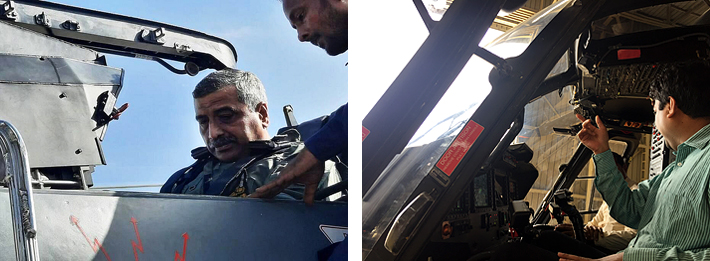
Challenges ahead
However, as the technology is further progressing, the various components and sub-components need to be developed. Take the case of Hypersonic Glide Vehicle (HGV) technology which is dependent on hypersonic aerodynamics, and materials, required for complex manoeuvring, like in the re-entry phase.
Testing infrastructure: Invariably, the key challenge will be to create the testing infrastructure –both lab testing and field testing. In the case of India, if not available then the government needs to set up like the case of Hypersonic Wind Tunnels.
It is worth mentioning that technology also needs to be certified to ensure quality control. The agencies operate in regulatory areas and are prone to resist the radical shift in bringing a new generation of technologies entirely into its class and applications. If these aspects are not addressed then the systems may be sub-optimal and fail altogether. India has learned its lesson in the case of LCA Tejas and TAPAS Drone in terms of regulatory delays in absorbing the technologies.
Manish Kumar Jha is a Consulting & Contributing Editor for SP's Aviation, SP's Land Forces and SP's Naval Forces and a security expert. He writes on national security, military technology, strategic affairs & policies.





